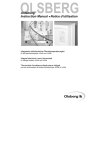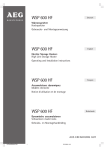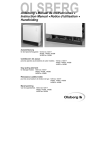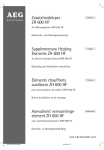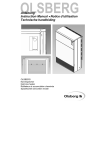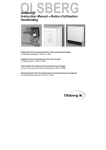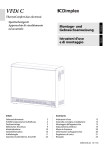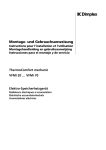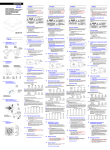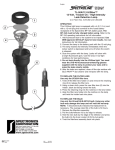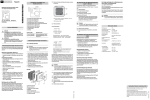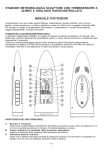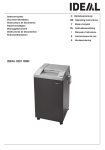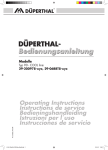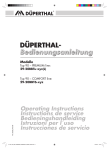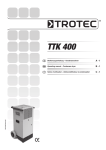Download Anleitung • Manual de instrucciones Instruction Manual • Notice d
Transcript
OLSBERG Anleitung • Manual de instrucciones Instruction Manual • Notice d’utilisation Handleiding Integrierter thermomechanischer Raumtemperaturregler für die Speicherheizgeräte 14/512 bis 14/517 14/553, 14/554, 14/556 Regulador termomecánico integrado de temperatura ambiente para los aparatos de calefacción con acumulador de calor modelos 14/512 al 14/517 14/553, 14/554, 14/556 Integral thermo-mechanical room thermostat for Storage Heaters 14/512 to 14/517 14/553, 14/554, 14/556 Thermostat d’ambiance thermomécanique intégré Pour les accumulateurs de chaleur électrique type 14/512 à 14/517 14/553, 14/554, 14/556 Geïntegreerde thermomechanische kamertemperatuurregelaar voor de warmteaccumulatoren 14/512 tot 14/517 14/553, 14/554, 14/556 D ........................3 - 7 E ........................8 - 12 GB ......................13 - 17 F ......................18 - 22 NL ......................23 - 27 2 Inhaltsübersicht • Bauteile .......................................................... Seite 3 D • Funktion .................................................................. 4 • Montage und elektrischer Anschluss ..................... 4 • Funktionsprüfung .................................................... 6 • Bedienung............................................................... 6 • Technische Daten................................................... 6 • Schaltplan ............................................................... 7 Bauteile Der Raumtemperaturregler besteht im wesentlichen aus: - Einstelleinheit mit Kapillarrohrregler und Wippenschalter für Zusatzheizung - Fühlereinheit mit Kapillarrohrfühler, Kunststoffgehäuse und Strahlenschutzblech KunststoffSchaltblende Einstelleinheit Bedienknopf Kapillarrohrregler beleuchteter Wippenschalter Fühlereinheit Kapillarrohrfühler nicht abgebildet: Dichtstreifen KunststoffGehäuse Strahlenschutzblech Zugentlastung 3 Funktion Der Kapillarrohrregler misst die Raumtemperatur und schaltet den Ventilatormotor bedarfsgerecht EIN und AUS. Kapillarrohrregler von vorn durch die Öffnung in der Vorderwand mit den beiliegenden Schrauben M4x6 am Reglerhalteblech anschrauben (Fig.2). Mit dem beleuchteten Wippenschalter kann eine Zusatzheizung (Zubehör) im Speicherheizgerät eingeschaltet werden. Bei Betrieb der Zusatzheizung leuchtet der Wippenschalter auf. Eine Nachtabsenkung um ca. 3K ist bei entsprechender Ansteuerung an Klemme TA – durch Handschalter, Schaltuhr oder Zentralsteuerung – möglich. Montage und elektrischer Anschluss • Die Montage und der elektrische Anschluss dürfen nur von einem Fachmann ausgeführt werden. • Gerät spannungsfrei schalten. Dazu die Stromzufuhr der Auf- und Entladestromkreise unterbrechen. Achtung: Auch bei ausgeschalteter Sicherung kann an den Hochtarifklemmen, insbesondere bei den Klemmen A1/Z1 und A2/Z2 für die Aufladeautomatik, Spannung anliegen. Fig.2 Kapillarrohrregler anschrauben • Bedienknopf auf die Achse des Kapillarrohrreglers aufstecken (Fig.3). • Die dem Speicherheizgerät beiliegende Anleitung ist grundsätzlich zu beachten. • Rechte Seitenwand und Abdeckhaube des Speicherheizgerätes losschrauben und abnehmen. Anstanzung aus Seitenwand herausbrechen. • Kunststoff-Schaltblende mit Hilfe eines SchlitzSchraubendrehers an den Haltelaschen, von der Geräteinnenseite, vorsichtig aus der Vorderwand herausknipsen (Fig.1). Hinweis: Setzen Sie den Schlitz-Schraubendreher möglichst nah von innen an der Vorderwand an. Fig.3 Fig.1 4 Kunststoff-Schaltblende mit Haltelaschen Bedienknopf aufstecken • Kunststoff-Schaltblende mit beleuchtetem Wippenschalter und Anschlussleitungen von vorn in die Öffnung in der Vorderwand einknipsen. Anschlussleitungen des Wippenschalters am Kapillarrohrregler und an der Schalttafelklemmleiste gemäß Schaltplan anschließen (Fig.4). • Anschlussleitungen des Kapillarrohrreglers an der Schalttafelklemmleiste gemäß Schaltplan anschließen (Fig.4). Achten Sie darauf, dass die Leitungen so verlegt sind, dass sie keine heißen Oberflächen berühren können, dass sie beim Montieren der Seitenwand nicht beschädigt oder abgequetscht werden können und dass keine inneren Leitungen durch die seitlichen Lüftungsschlitze von außen berührbar sind (beiliegenden Kabelbinder verwenden). • Flusensieb herausnehmen (Fig.4, nicht dargestellt) und Gitterblech für Flusensieb abschrauben. • Kapillarrohrleitung mit Kapillarrohrfühler durch den Schlitz zwischen Vorderwand / Trennblech und durch den Ventilatorraum führen (Fig.4). Gitterblech für Flusensieb in Stützblech einstecken und links anschrauben. Achten Sie dabei darauf, dass die Kapillarrohrleitung mit dem Kapillarrohrfühler unter der Abkantung des Gitterblech für Flusensieb nach außen geführt ist (Fig.4). • Fühlereinheit an rechter Seitenwand befestigen. Dazu Kapillarrohrfühler durch das Strahlenschutzblech und von innen durch die Seitenwand führen (Fig.5). Kapillarrohrfühler in die Halterungen im Kunststoff-Gehäuse eindrücken. Kunststoff-Gehäuse (Seitenwand außen), Strahlenschutzblech und Zugentlastung miteinander verschrauben. Benutzen Sie dazu die beiliegenden Schrauben 2,9x9,5 (Fig.5). Zugentlastung mit Befestigungsschraube des Gitterblech für Flusensieb am Gerät befestigen (Fig.5). Fig.5 Fig.4 Strahlenschutzblech und Zugentlastung Kapillarrohrregler verdrahtet (ohne Flusensieb dargestellt) 5 • Beiliegenden Dichtstreifen, von rechts beginnend, auf die obere Abkantung der Vorderwand kleben. Funktionsprüfung Die Funktion des Integrierten Raumtemperaturreglers ist wie folgt zu prüfen: • Bedienknopf herausdrücken und in Stellung „6“ drehen. Der Ventilator läuft. • Bedienknopf in Stellung „Linksanschlag“ drehen. Der Ventilator darf nicht laufen. • Nur bei Zusatzheizung: Die Zusatzheizung lässt sich nur bei nicht aufgeladenem Speicherheizgerät einschalten. Bedienknopf in Stellung „6“ drehen und Wippenschalter einschalten. Der Wippenschalter muss aufleuchten und die Zusatzheizung in Betrieb sein. Fig.6 Dichtstreifen auf Vorderwand-Abkantung • Flusensieb einsetzen und Gerät wieder verschließen. Achten Sie vor dem Wiederanschrauben der rechten Seitenwand darauf, dass das Flusensieb richtig eingelegt ist. Hinweis: Es ist darauf zu achten, dass ein Mindestmaß von 10cm zwischen Gebäudewand und rechter Speicherheizgerätewand eingehalten wird. Die seitlichen Lüftungsschlitze dürfen nicht mit Gegenständen zugestellt werden. Bedienung Der Einstellbereich der Raumtemperatur liegt zwischen 7°C (Stellung „1“) und ca. 30°C (Stellung „6“) und kann in diesem Bereich stufenlos eingestellt werden. Durch Betätigen des Wippenschalters wird die Zusatzheizung EIN- und AUS-geschaltet. Leuchtet der Wippenschalter auf, so ist die Zusatzheizung eingeschaltet und der integrierte Raumtemperaturregler arbeitet. Achtung! Mit dem Raumtemperaturregler allein kann kein Frostschutz gewährleistet werden. Grundvoraussetzung ist ein ausreichend aufgeladenes Speicherheizgerät. Technische Daten - Temperatur-Einstellbereich............................ ca. 7° bis 30°C - Schaltdifferenz................................................ ca. 1,5K - Temperaturabsenkung über TA..................... ca. 3K - Nennspannung ............................................... 230V ~ 50/60Hz - Max. Anschlussleistung ................................. 10 (4) A - Anschlussleistung Zusatzheizung ................. 230V 10A (ohmsche Last) - Funkentstörung .............................................. Funkentstörgrad N 6 Schaltplan 1) 78/4514.5103 Klemme TA: 230V-Signal zur Temperaturabsenkung Technische Änderungen behalten wir uns vor. Bei Garantiefällen gelten die landesspezifischen Rechtsansprüche, die Sie bitte direkt gegenüber Ihrem Händler geltend machen. 7 Índice E • Componentes ............................................. Página 7 • Funcionamiento.......................................................8 • Montaje y conexión eléctrica ..................................8 • Comprobación del funcionamiento .......................10 • Manejo ...................................................................10 • Datos técnicos.......................................................10 • Esquema eléctrico.................................................11 Componentes El regulador de temperatura ambiente se compone esencialmente de: - Unidad de regulación con regulador de tubo capilar e interruptor de tecla basculante para la calefacción adicional - Unidad sensora con sensor de tubo capilar, carcasa de material sintético y chapa protectora contra radiaciones Carátula de material sintético Unidad de regulación Regulador de tubo capilar Botón de mando Interruptor con lámpara piloto Unidad sensora Sensor de tubo capilar no representado: banda de junta Carcasa de material sintético Chapa protectora contra radiaciones Cable de seguridad a la tracción 8 Funcionamiento El regulador de tubo capilar mide la temperatura ambiente y conecta o desconecta el motor del ventilador de acuerdo con las necesidades. • Por delante, y a través de la abertura del frontal anterior, atornillar el regulador de tubo capilar a la chapa soporte del regulador, con los tornillos de M4x6 adjuntos (Fig.2). Con el interruptor con lámpara piloto se puede conectar la calefacción de apoyo (accesorio) en el aparato de calefacción con acumulador de calor. Cuando funciona la calefacción de apoyo, el interruptor se ilumina. Se puede conseguir un descenso de aprox. 3K durante la noche con la correspondiente excitación en el borne TA - mediante un interruptor manual, reloj conmutador o dispositivo central de mando. Montaje y conexión eléctrica • El montaje y la conexión eléctrica solamente los debe realizar un profesional. • Desconectar el aparato de la tensión. Para ello interrumpir la entrada de corriente del circuito de carga y descarga. Atención: Incluso con la seguridad desconectada, puede haber tensión en las bornas A1/Z1 y A2/Z2 para la carga automática. • Tener en cuenta el manual de instrucciones que se encuentra en el aparato. Fig.2 Atornillado del regulador de tubo capilar • Insertar el botón de mando sobre el eje del regulador de tubo capilar (Fig.3). • Desatornillar y retirar el panel lateral derecho y la tapa del acumulador de calor. Presionar sobre la superficie troquelada situada en la parte inferior del panel. • Con un destornillador plano, liberar con cuidado las orejas de sustentación de la carátula de material sintético que lo fijan al panel anterior del aparato por su parte interior (Fig.1). Observación: Coloque el destornillador por el interior, lo más cerca posible del frontal anterior. Fig.3 Fig.1 Inserción del botón de mando Carátula de material sintético con orejas de sustentación 9 • Por delante, introducir a presión en la abertura de la pared delantera la carátula de material sintético junto con el interruptor con lámpara piloto y los cables de conexión. Conectar los cables de conexión del interruptor al regulador de tubo capilar y a la regleta de bornes del cuadro de distribución, de acuerdo con el esquema eléctrico (Fig.4). • Conectar los cables del regulador de tubo capilar a la regleta de bornes del cuadro de distribución, de acuerdo con el esquema eléctrico (Fig.4). Preste atención que los cables se tiendan de manera que no puedan tocar ninguna superficie caliente, que al montar el panel lateral no puedan resultar dañados o aplastados y que a través de las rendijas de ventilación laterales no pueda entrar en contacto con ningún conductor interior (utilícense las abrazaderas para cables adjuntas). • Extraer el filtro para pelusa (no representado en la Fig.4) y desatornillar la chapa perforada para el mismo. • Pasar la conducción de tubo capilar junto con el sensor de tubo capilar a través de la rendija entre el panel delantero y la chapa de separación y a través del recinto del ventilador (Fig.4). Insertar y atornillar la chapa perforada por la izquierda para el filtro para pelusa. Preste atención a que la conducción de tubo capilar juntamente con el sensor de tubo capilar queden situados hacia fuera por debajo del rebordeado de la chapa perforada para el filtro para pelusa (Fig.4). • Fijar la unidad sensora al panel lateral derecho. Para ello, pasar el sensor de tubo capilar a través de la chapa de protección contra radiaciones y, desde el interior, pasarlo a través del panel lateral (Fig.5). Insertar a presión el sensor de tubo capilar en los soportes de la carcasa de material sintético. Atornillar entre sí la carcasa de material sintético (panel lateral exterior), la chapa de protección contra radiaciones y el dispositivo de descarga de tracción. Utilice para ello los tornillos de 2,9x9,5 adjuntos (Fig.5). Fijar el cable de seguridad a la tracción al aparato mediante el tornillo de fijación de la chapa perforada para el filtro para pelusa (Fig.5). Fig.5 Fig.4 10 Regulador de tubo capilar, cableado (representado sin el filtro para pelusa) Chapa de protección contra radiaciones y cable de seguridad a la tracción • Adherir la banda de junta que se entrega, empezando por la parte derecha hacia el borde superior del panel frontal. Comprobación del funcionamiento El funcionamiento del regulador integrado de temperatura ambiente se comprobará como sigue: • Pulsar el botón retráctil de mando y girarlo a la posición "6". • Girar el botón de mando a la posición "paro en la parte izquierda". El ventilador no debe girar. • Sólo en aparatos con calefacción de apoyo: La calefacción de apoyo solamente se puede conectar cuando el aparato de calefacción con acumulador de calor no está cargado. Girar el botón de mando a la posición "6" y conectar el interruptor luminoso. Este tiene que iluminarse y la calefacción adicional estará en servicio. Fig.6 Junta en el borde superior del panel frontal • Colocar el filtro para pelusa y cerrar de nuevo el aparato. Antes de atornillar de nuevo la panel lateral derecho cerciórese de que el filtro para pelusa está colocado correctamente. Observación: Hay que prestar atención a que entre la pared del edificio y el panel derecho del aparato de calefacción con acumulador de calor se mantenga una separación mínima de 10cm. Las rendijas laterales de ventilación no tienen que quedar bloqueadas por ningún objeto. Manejo La gama de regulación de la temperatura ambiente se sitúa entre 7°C (Posición "1") y aproximadamente 30°C (Posición "6"), y dentro de esta gama se puede regular de manera continua. Mediante accionamiento del interruptor, se puede conectar y desconectar la calefacción de apoyo. Cuando este interruptor se ilumina, la calefacción adicional está conectada y el regulador integrado de temperatura ambiente se halla en servicio. Atención: El termostato de temperatura ambiente no garantiza una protección contra heladas. La precondición es que el acumulador esté suficientemente cargado. Datos técnicos - Gama de regulación de la temperatura .............. desde aprox. 7°C hasta 30°C - Diferencia de conmutación.............. ................... aprox. 1,5K - Tensión nominal.............................. ................... 230V ~ 50/60Hz - Intensidad máx. de conexión.............................. 10 (4) A - Intensidad de conexión de la calefacción de apoyo .......... 230V 10A (carga óhmica) - Supresión de interferencias ................................ Grado de supresión deinterferencias: N 11 Esquema eléctrico 1) 78/4514.5103 Circuito adicional: termostato ambiente integrado termomecánico Alimentación 1/N/PE~230V B2 E2 F2.1 F2.2 F3 M1 R2.1 R2.2 SZ Regulador integrado de temperatura ambiente Resistencia de apoyo Limitador para el desbloqueo Limitador de temperatura Limitador térmico de seguridad Turbina Resistencia aceleradora para termostato ambiente Resistencia de reducción nocturna de temperatura Interruptor luminoso para calefacción de apoyo Modificaciones técnicas reservadas. En caso de garantía, sólo son válidas las condiciones generales del país, de las cuales usted puede beneficiarse junto con su comerciante. 12 Contents GB • Components.................................................Page 13 • Function ................................................................ 14 • Installation and electrical connection ................... 14 • Test of function ..................................................... 16 • Operation .............................................................. 16 • Technical Data...................................................... 16 • Circuit Diagram ..................................................... 17 Components The room thermostat consists essentially of the following components: - Setting adjuster with capillary tube thermostat and rocker switch for day-acting element - Sensor unit with capillary sensor, plastic housing and heat-protection plate Plastic fascia plate Setting adjuster Capillary-tube thermostat Adjuster knob Illuminated rocker switch Sensor unit Capillary tube sensor not shown: Sealing strip Plastic housing Heat-protecting plate Strain relief 13 Function The capillary tube thermostat measures the room temperature and switches the fan ON or OFF accordingly. • Fix the capillary-tube thermostat to the fixing plate through the opening in the front panel using the M4x6 fixing screws supplied (Fig.2). A day-acting element (supplied as an accessory) in the storage heater can be switched by means of the illuminated rocker switch. The switch lights up when the DAE is in operation. A night-time set back of ca. 3K can be achieved by a control current on terminal TA, for instance by a manual switch, time-clock or central control. Installation and Electrical Connection • The installation and Electrical Connection may only be carried out by a competent electrician. • Turn off all electricity supplies to the heater. To do this, interrupt the electricity supply to both the charge and the discharge circuits. Caution! Even if the main circuit breakers are switched off, some terminals carrying on-peak current, especially terminals A1/Z1 and A2/Z2 can still be live. Fig.2 Fixing the capillary-tube thermostat • Push the adjuster knob on to the spindle of the capillary thermostat (Fig.3). • Also read the Instruction Leaflet supplied with the storage heater. • Remove the right-hand side panel and cover panel of the storage heater. Break out the knock-outs in the side panel. • Carefully remove the plastic fascia plate from the inside of the heater front panel using a screwdriver to gently push out the holding tabs (Fig.1). Attention: The angle of the screwdriver should be set as close as possible to the inside of the front panel (oblique angle prevents breakage of the fascia plate and/or chipping of the paint-work). Fig.3 Fig.1 14 Plastic fascia plate with holding tabs Push on adjuster knob • Clip in the plastic fascia plate with the illuminated rocker switch and connecting cables through the opening in the front of the heater. Connect the cables from the rocker switch to the capillary-tube thermostat and to the terminal strip according to the circuit diagram (Fig.4). • Connect the cables from capillary-tube thermostat to the terminal strip according to the circuit diagram (Fig.4). Make sure that the wires are not touching any hot surfaces, that they are neither damaged nor squeezed when replacing the side panel and that no internal wiring is touchable from the outside through the air-slits (use the cable binders provided). • Remove the fluff filter (Fig.4, not shown) and its corresponding fixing plate. • Thread the capillary tubing and capillary sensor bulb through the slit between the front panel / separation plate and then through the fan compartment (Fig.4). Replace the fluff filter fixing plate and screw on. Make sure that the capillary tube and the capillary sensor bulb are thread outwards below the edge of the fluff filter fixing plate (Fig.4). • Fix the sensor unit to the right hand side panel. The capillary sensor should be threaded through the heat protection plate and front the inside through the side panel (Fig.5). Push the capillary sensor bulb into the bracket in the plastic housing. Screw the plastic housing (outer side panel), heat protection plate and strain relief together. Use the 2.9x9.5 screws provided for this purpose (Fig.5). Fix the strain relief to the heater with the fluff filter plate fixing screw (Fig.5). Fig.5 Fig.4 Heat protection plate and strain relief Wired capillary-tube (shown without fluff filter) 15 • Fix the sealing strip supplied on to the upper edge of the front panel, beginning at the right hand side. Test of function The function of the integral room thermostat is to be tested as follows: • Push out the adjuster knob and turn it to setting "6“. The fan runs. • Turn the adjuster knob to setting "stop on the lefthand side". The fan must not run. • Only with a day-acting element:Turn the adjuster knob to setting „6“ and switch the rocker switch to on. The rocker switch must light up and the day-acting element must be energised. Fig.6 Sealing strip on the front panel edge • Replace the fluff filter and close the heater back up. Before fixing the right-hand side panel back on, make sure that the fluff filter is correctly in place. Attention: A minimum clearance of 10cm between the right-hand side panel and the wall of the room to be heated must be kept. The air slits in the side panel must not be covered by any objects. Technical Data Operation The adjustment range for the room temperature lies between 7°C (Setting „1“) and ca. 30°C (Setting „6“) and can be infinitely varied between these settings. By using the rocker switch the day-acting element can be turned ON and OFF. If the rocker switch is illuminated, it shows that the DAE is switched on and that the thermostat is functioning. Caution! The room thermostat alone is no guarantee of frost protection. The basic requirement for this is a sufficient charge in the storage heater. - Temperature setting range ............................ ca. 7° to 30°C - Switching range ............................................. ca. 1,5K - Temperature decrease via TA ....................... ca. 3K - Nominal voltage.............................................. 230V ~ 50/60Hz - Max. Power draw ........................................... 10 (4) A - Power draw day-acting element .................... 230V 10A (resistive load) - Noise suppression.......................................... Suppression grade N 16 Circuit Diagram 1) 78/4514.5103 Additional circuit: Integral thermo-mechanical room thermostat Connection cable 1/N/PE~230V B2 E2 F2.1 F2.2 F3 M1 R2.1 R2.2 SZ Integral room thermostat Day-acting element Thermal release thermostat Safety thermostat Fan safety cut-out Fan Accelerator resistance for room thermostat Night set-back resistance Illuminated rocker switch for day-acting element Terminal TA: 230V signal for temperature decrease We reserve the right to make any technical changes. In guarantee case the country specified rights are valid which you may claim directly towards your dealer. 17 Sommaire F • Composition .................................................page 18 • Fonctionnement.....................................................19 • Montage et raccordement électrique....................19 • Vérification du fonctionnement .............................21 • Utilisation ...............................................................21 • Caractéristiques techniques .................................21 • Schéma de raccordement.....................................22 Composition Le thermostat d’ambiance se compose principalement des éléments suivants: - Unité de réglage avec thermostat à capillaires et interrupteur lumineux pour résistance additionnelle - Unité sonde avec sonde à capillaires, boîtier plastique et plaque de protection à la chaleur Panneau de commande plastique Unité de réglage Bouton de réglage Thermostat à capillaires Interrupteur lumineux Unité sonde Sonde à capillaires sans illustration: Bande hermétique Boîtier plastique Tôle de protection contre la chaleur Décharge de tension 18 Fonctionnement Le thermostat à capillaires mesure la température ambiante et enclenche ou stoppe le moteur du ventilateur en fonction des besoins. • Vissez le thermostat à capillaires à la plaque de support en passant par l’ouverture de la paroi frontale à l’aide des vis M4x6 jointes (Fig.2). Une résistance additionnelle (accessoire) peut être mise en route à l’intérieur de l’appareil grâce à l’interrupteur lumineux. L’interrupteur est allumé quand la résistance fonctionne. Il est possible d’obtenir une diminution nocturne d’environ 3K grâce à un réglage sur la borne TA, par exemple à l’aide d’un interrupteur manuel, d’une minuterie ou d’une régulation centrale. Montage et raccordement électrique • Le montage et le raccordement électrique doivent être effectués par un professionnel. • Coupez toute les alimentations électriques de l’appareil, que ce soit au niveau de la charge ou de la décharge. Attention: Même en cas de coupure du courant, il peut subsister de la tension à l’intérieur de l’appareil, et particulièrement aux bornes A1/Z1 et A2/Z2. • Lisez également le manuel d’utilisation joint au l’accumulateur de chaleur. Fig.2 Vissez le thermostat à capillaires • Fixez le bouton de réglage sur l’axe du thermostat à capillaires (Fig.3). • Enlevez les vis de la paroi latérale droite et du couvercle de l’accumulateur et cassez les matrices de la paroi droite. • Séparez avec précaution la plaque de raccordement plastique de la paroi frontale interne de l’appareil à l’aide d’un tournevis pour décoller les supports (Fig.1). Conseil: Rapprochez le tournevis le plus possible de l’intérieur de la paroi frontale de l’appareil. Fig.3 Fig.1 Fixez le bouton de réglage Panneau de commande plastique avec supports 19 • Clipser la plaque de raccordement plastique comprenant l’interrupteur lumineux et les câbles de raccordement à la paroi frontale à travers l’ouverture. Raccordez les câbles de l’interrupteur lumineux au thermostat à capillaires et à la borne du tableau de raccordement conformément au schéma de branchement (Fig.4). • Raccordez les câbles du thermostat à capillaires à la borne du tableau de raccordement conformément au schéma de branchement (Fig.4). Veillez que les câbles soient positionnés de manière à ce qu’ils ne soient pas en contact avec des surfaces chaudes, qu’ils ne puissent pas être endommagés ou pincés lors du montage de la paroi latérale et que les câbles intérieurs ne puissent pas être atteints de l’extérieur à travers les canaux d’aération latéraux. Utilisez les liens des câbles fournis. • Retirez le filtre à impuretés (Fig.4, non représenté) et dévissez sa grille. • Faites passer le câble à capillaires avec la sonde à capillaires dans l’espace entre la paroi frontale et la tôle de séparation à travers l’habitacle du ventilateur (Fig.4). Fixez la grille du filtre dans la tôle de protection et vissez-la. Vérifiez que le câble à capillaires avec la sonde soit passé vers l’extérieur sous le coin de la grille du filtre (Fig.4). • Fixez l’unité sonde à la paroi latérale droite. Pour cela, faites passer la sonde à capillaires à travers la tôle de protection contre la chaleur et de l’intérieur à travers la paroi latérale (Fig.5). Poussez la sonde sur les supports dans le boîtier plastique. Vissez ensemble le boîtier plastique (à l’extérieur de la paroi latérale), la plaque de protection thermique et la décharge de traction. Utilisez pour cela les vis 2,9x9,5 fournies (Fig.5). Fixez la décharge de tension à l’appareil grâce aux fixations de la grille du filtre à impuretés (Fig.5). Fig.5 Fig.4 20 Thermostat à capillaires relié (représenté sans filtre à impuretés) Plaque de protection thermique et décharge de tension • Collez la bande hermétique fournie en partant de la droite sur l'arête supérieure de la paroi frontale. Vérification du fonctionnement Vérifiez le fonctionnement du thermostat d’ambiance de la manière suivante: • Tirez sur le bouton de réglage et mettez-le en position „6“. Le ventilateur fonctionne. • Mettez le bouton de réglage en position „arrêt à la gauche“. Le ventilateur ne doit pas fonctionner. • Si vous avez une résistance additionnelle: Placez le bouton de réglage en position „6“ et enclenchez l’interrupteur lumineux. L’interrupteur doit être allumé et la résistance fonctionner. Fig.6 Bande hermétique sur l'arête de la paroi frontale • Replacez le l’appareil. filtre à impuretés et refermez Veillez à ce que le filtre à impuretés soit correctement installé avant de revisser la paroi latérale droite. Conseil: Vérifiez qu’il y a un espace d’au moins 10cm entre le mur de votre pièce et la paroi latérale droite. De même, ne recouvrez pas les canaux de sortie d’air latéraux. Caractéristiques techniques Utilisation Le créneau de réglage de la température ambiante est situé entre 7°C (position „1“) et env. 30°C (position „6“) et peut être réglé de manière linéaire. La résistance additionnelle sera mise en marche ou stoppée grâce à l’interrupteur lumineux. Si l’interrupteur est allumé, la résistance additionnelle est en marche et le thermostat fonctionne. Attention! Une protection contre le gel ne peut être obtenue avec le seul thermostat d'ambiance. La condition sine qua non de cette protection est un accumulateur suffisamment chargé. - Créneau de réglage de température ........ env. 7° à 30°C - Différence de branchement ...................... env. 1,5K - Abaissement de température ................... env. 3K - Tension nominale...................................... 230V ~ 50/60Hz - Puissance de raccordement max ............. 10 (4) A - Puissance (résistance additionnelle)........ 230V 10A (charge) - Réduction du bruit..................................... Degré de réduction N 21 Schéma de raccordement 1) 78/4514.5103 Circuit additionnel: Thermostat d’ambiance thermomécanique intégré Câble Connexion 1/N/PE~230V B2 E2 F2.1 F2.2 F3 M1 R2.1 R2.2 SZ Thermostat d’ambiance intégré Résistance additionnelle Thermostat de déclenchement Thermostat de sécurité Thermostat de sécurité du ventilateur Ventilateur Résistance de compensation pour thermostat d’ambiance Résistance pour diminution nocturne Interrupteur lumineux pour résistance additionnelle Borne TA: Commande d’abaissement de température automatique par horloge de programmation par ex. Sous réserve de modifications techniques. En cas de garantie, ne sont valables que les conditions générales du pays, que vous pouvez faire valoir auprès de votre commerçant. 22 Inhoudsoverzicht NL • Componenten ...........................................Pagina 23 • Functie .................................................................. 24 • Montage en elektrische aansluiting...................... 24 • Functiecontrole ..................................................... 26 • Bediening .............................................................. 26 • Technische gegevens........................................... 26 • Schakelschema .................................................... 27 Componenten De kamertemperatuurregelaar bestaat in principe uit: - Insteleenheid met capillaire buisregelaar en wipschakelaar voor extra verwarming - Voelereenheid met capillaire buisvoeler, kunststof behuizing en bevestigingshouder Kunststof schakelpaneel Insteleenheid Bedienknop Capillaire buisregelaar Verlichte wipschakelaar Voelereenheid Capillaire buisvoeler Niet afgebeeld: afdichtstroken Kunststofbehuizing Bevestigingshouder Snoerontlasting 23 Functie De capillaire buisregelaar meet de kamertemperatuur en schakelt de motor van de ventilatormotor naar behoefte AAN en UIT. De capillaire buisregelaar van voren door de opening in de voorwand steken en met de bijgevoegde schroeven M4x6 aan de houdplaat van de regelaar vastschroeven (Fig.2). Met de verlichte wipschakelaar kan een extra verwarming (accessoires) in de warmteaccumulator ingeschakeld worden. Tijdens het gebruik van de extra verwarming is de wipschakelaar verlicht. Een nachtverlaging van ca. 3K is bij een passende aansturing aan klem TA – door handschakelaar, schakelklok of centrale aansturing – mogelijk. Montage en elektrische aansluiting • De montage en elektrische aansluiting mogen uitsluitend door een vakman uitgevoerd worden. • Apparaat spanningsvrij schakelen. Hiervoor de stroomtoevoer van de op- en ontlaadstroomcircuits onderbreken. Attentie: Ook als de zekering uitgeschakeld is, kan er op de klemmen voor hoog tarief, vooral bij de klemmen A1/Z1 en A2/Z2 voor de oplaadregeling, spanning staan. • De bij de warmteaccumulator bijgevoegde montagehandleiding dient te worden opgevolgd. Fig. 2 Capillaire buisregelaar vastschroeven • Bedienknop op de as van de capillaire buisregelaar steken (Fig.3). • Rechter zijwand en afdekkap van de warmteaccumulator losschroeven en verwijderen. Ingestanst gedeelte uit de zijwand breken. • Kunststof schakelpaneel voorzichtig uit de voorwand duwen door vanuit de binnenkant van het apparaat de vasthoudstrips met behulp van een sleufschroevendraaier weg te drukken (Fig.1). Instructie: Zet de sleufschroevendraaier van binnen uit zo dicht mogelijk tegen de voorwand aan. Fig. 3 Bedienknop opsteken Fig. 1 Kunststof schakelpaneel met vasthoudstrips 24 • Kunststof schakelpaneel met de verlichte wipschakelaar en de aansluitleidingen in de opening van de voorwand drukken Aansluitleidingen van de wipschakelaar aan de capillaire buisregelaar en aan de klemlijst aansluiten volgens het schakelschema (Fig.4). • Aansluitleidingen van de wipschakelaar aan de capillaire buisregelaar en aan de klemlijst aansluiten volgens het schakelschema (Fig.4). Let erop dat de leidingen zodanig gelegd zijn dat ze niet in aanraking kunnen komen met hete oppervlakken, dat ze bij het monteren van de zijwand niet beschadigd of afgeklemd kunnen worden en dat de ventilatieopeningen aan de zijkant niet van buitenaf aangeraakt kunnen worden (bijgevoegde kabelbinder gebruiken). • Pluizenzeef eruit halen (Fig.4, niet afgebeeld) en roosterplaat voor pluizenzeef losschroeven. • De capillaire buisleiding met de capillaire buisvoeler door de sleuf tussen voorwand / scheidingsplaat en de ventilatorruimte leiden (Fig.4). Roosterplaat voor pluizenzeef in de steunplaat steken en links vastschroeven. Let er hierbij op dat de capillaire buisleiding met de capillaire buisvoeler onder de rand van de roosterplaat voor het pluizenzeef naar buiten geleid is (Fig.4). • Voelereenheid aan de rechter zijwand bevestigen. Hiervoor moet de capillaire buisvoeler door de bevestigingshouder en van binnen door de zijwand geleid worden (Fig.5). De capillaire buisvoeler in de houders van de kunststof behuizing drukken. Kunststof behuizing (zijwand buitenkant), bevestigingshouder en snoerontlasting aan elkaar vastschroeven. Maak hiervoor gebruik van de bijgevoegde schroeven 2,9x9,5 (Fig.5). Snoerontlasting met bevestigingsschroef van de roosterplaat voor het pluizenzeef aan het apparaat bevestigen (Fig.5). Fig. 5 Bevestigingshouder en snoerontlasting Fig. 4 Capillaire buisregelaar bedraad (zonder pluizenzeef afgebeeld) 25 • De bijgevoegde afdichtstroken, rechts beginnend, op de bovenste rand van de voorwand plakken. Functiecontrole De functie van de geïntegreerde kamertemperatuurregelaar moet als volgt gecontroleerd worden: • Bedienknop naar buiten drukken en op stand „6“ draaien. De ventilator loopt. • Bedienknop op stand „linker aanslag“ draaien. De ventilator mag niet lopen. • Uitsluitend bij extra verwarming: De extra verwarming kan uitsluitend ingeschakeld worden als de warmteaccumulator niet opgeladen is. Bedienknop op stand „6“ draaien en de wipschakelaar inschakelen. De wipschakelaar moet verlicht zijn en de extra verwarming moet in gebruik zijn. Fig. 6 Afdichtstroken op de rand van de voorwand • Pluizenzeef inzetten en het apparaat weer sluiten. Voordat u de rechter zijwand weer vastschroeft, moet u erop letten dat het pluizenzeef correct geplaatst is. Instructie: Er moet op gelet worden dat er tussen de muur van het gebouw en de rechterwand van de warmteaccumulator een minimale afstand van 10cm aangehouden wordt. De ventilatieopeningen aan de zijkant mogen niet geblokkeerd worden door eventuele voorwerpen. Bediening Het instelbereik van de kamertemperatuur ligt tussen 7°C (stand „1“) en ca. 30°C (stand „6“) en kan traploos binnen dit bereik ingesteld worden. Door op de wipschakelaar te drukken wordt de extra verwarming AAN en UIT gezet. Als de wipschakelaar verlicht is, dan is de extra verwarming ingeschakeld en werkt de geïntegreerde kamertemperatuurregelaar. Attentie! Alleen met de kamertemperatuurregelaar is geen bescherming tegen vorst gegarandeerd. De voornaamste voorwaarde hiervoor is een warmteaccumulator die voldoende opgeladen is. Technische gegevens - Temperatuur-instelbereik............................... ca. 7° tot 30°C - Schakeldifferentie........................................... ca. 1,5K - Temperatuurverlaging via TA ........................ ca. 3K - Nominale spanning ........................................ 230V ~ 50/60Hz - Max. aansluitvermogen.................................. 10 (4) A - Aansluitvermogen extra verwarming ............. 230V 10A (ohmse last) - Radio ontstoring ............................................. Radio ontstoringsgraad N 26 Schakelschema 1) 78/4514.5103 Extra schakeling: Ingebouwde thermomechanische kamertemperatuurregelaar kabel B2 Geïntegreerde kamertemperatuurregelaar E2 Extra verwarming F2.1 Regelaar vrijgave extra verwarming F2.2 Oververhittingsbeveiliging extra verwarming F3 Temperatuursensor ventilator M1 Ventilator R2.1 Compensatieweerstand kamertemperatuurregelaar R2.2 Weerstand voor verlaging van de kamertemperatuur SZ Verlichte wipschakelaar voor extra verwarming Klem TA: 230V signaal voor temperatuurverlaging Technische wijzigingen voorbehouden. Bij garantiegevallen gelden de landspecifieke wettige aanspraken, die u rechtstreeks bij uw handelaar kunt kenbaar maken. 27 10/2008 www.olsberg.com 5) 78/4614.5103 Hüttenstraße 38 • D - 59939 Olsberg Telefon +49 / (0) 29 62 / 8 05 – 0 Telefax +49 / (0) 29 62 / 8 05 – 180 Email [email protected]




























